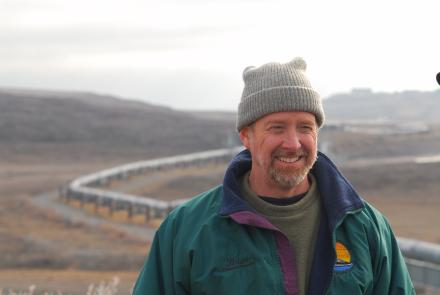Not Everything Hates Cold Weather
If Alaskans could choose the type of weather they lived in, I suspect most would pick a year like the Interior had in 1995--one with a mild winter, an early, dry spring and a sunny summer. One would think most living organisms would share our preference for warm and dry years, but a researcher recently found white spruce trees that thrive on the opposite.
Glenn Juday, an associate professor of forest sciences at the University of Alaska Fairbanks, studies the growth of two stands of trees about 30 miles down the Parks Highway from Fairbanks. One stand, in Rosie Creek, was burned in 1983. The other was attacked by bark beetles in 1985 and sold to loggers in 1987. By counting tree rings and measuring their width, Juday discovered the trees grew best in the coolest, wettest years.
Different tree ring studies done on isolated trees at high elevation show contrasting results: the warmer the temperature in any given year, the better trees grow. That makes sense. Look at trees on a sunny, south-facing slope and chances are they'll be a lot bigger than ones on a colder, north-facing slope.
The cold-loving white spruce in Juday's study differ from those sampled in previous tree ring studies because they grow in the upland--between rivers and mountain tops. They also grow close together, and compete against one another for moisture and sunlight.
Juday first noticed the upland white spruce's taste for cold weather when his son Benjamin did a high school science fair project. Benjamin plotted yearly temperatures versus the thickness of tree rings from the stands his father studies. Positive spikes of years with beefy tree rings matched up with downward spikes that indicated low temperatures.
Why do these trees prefer cold weather? Juday thinks long, cold winters and cold, wet summers free up more water for trees to drink. In cooler years, less moisture is lost to evaporation and through the leaves of trees than in warmer, drier years.
Juday's research shows more than upland white spruce's apparent preference for cold weather; it shows the trees are in trouble.
Because the white spruce he's studying have left a record of the past 200 years in their rings, Juday notices a cycle of tree growth crashes and recoveries that correlates well with an index of local temperatures and precipitation. The index, compiled from Fairbanks weather records from 1904 to the present, shows a trend of unprecedented high temperatures and low precipitation that began in the late 1970's. According to Juday, the recent warm, dry weather has hurt the upland white spruce.
Spruce bark beetles, spruce bud worms and other insects are attacking the stands. Juday says the trees, stressed by the lack of moisture, are giving off chemical signals that draw insects like iron shavings to a magnet. Spruce bud worms turn spruce needles brown, and bark beetles often kill spruce trees by tunneling under the bark.
A change in the weather is needed for the trees to recover, Juday says.
"What would really help right now are some cold, prolonged winters, and a few cool, rainy summers," Juday says. "All this wonderful weather we've been having in recent years has been coming at the expense of the trees."
The troubled white spruce mean more to Juday than just lines on a graph. He sees them as a tiny piece of the climate change puzzle. When combined with other evidence, such as recent studies of disappearing permafrost, a picture of a warming world could come into focus.
While he's quick to point out that the change he sees is a very local one, it's a severe change from which white spruce trees may not recover unless things cool off a bit.
So the next time a few weeks of 30 below stall the car, or when waves of rain wash out a May canoe trip, think of how the weather is helping the spruce trees, and smile.





